Follow Me
Latest Posts
- Organize Your Desktop with Your Perfect Desk Pad: 2025 Update
- How to Use Timers for Improved Productivity — Part 5: Hybrid Timers and Bonus Material
- How to Use Timers for Improved Productivity and Focus — Part 4: Digital Timers
- How to Use Timers for Improved Productivity and Focus — Part 3: Tangible Timers
- How to Use Timers for Improved Productivity and Focus — Part 2: Pick the Right Timer
Search Best Results Organizing
Subscribe to the Paper Doll Blog via Email
Take Note: Paper Doll’s Guide to Organized Note-Taking (Part 1)
Posted on: February 3rd, 2025 by Julie Bestry | 11 Comments
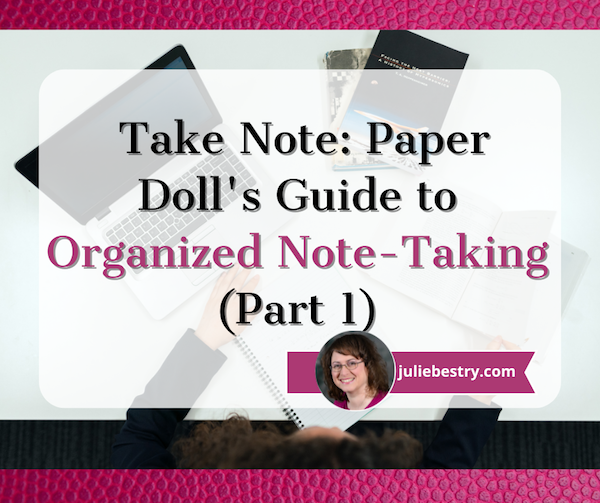
Have you ever seen a sign with the letters “N.B.” on it or a set of instructions where the highlighted part says N.B.?
N.B. is short for nota bene, the Latin for “note well,” or in our own vernacular, “Hey, take note!” and until about thirty years ago, it was common to see N.B. on documents, notices, and signs, warning that something was important.
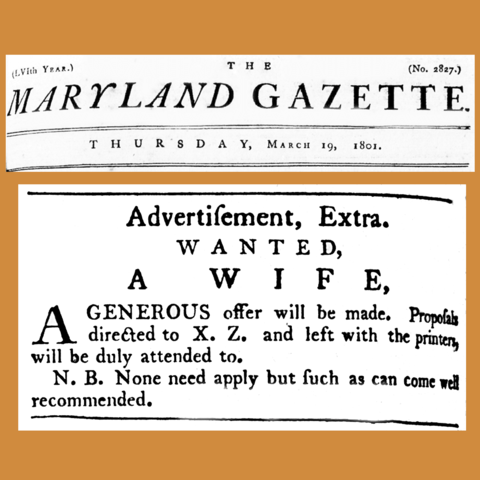
The Maryland Gazette (March 19, 1801). “Wanted, A Wife (Advertisement, Extra)” Public Domain Link
We may not use the Latin abbreviation much anymore, but we sure do have a lot of things to which we need to pay attention, or pay heed, or take note! Today, we’re going to look at different areas of our lives in which we need to capture and organize information by taking notes.
The inspiration for today’s post was friend-of-the-blog Dr. Frank Buck. Recently, I sat down again with Frank for his fabulous podcast Get Organized!, to talk about note-taking in all of its myriad forms.
In the episode entitled, Your Note-taking Just Got Better (with Julie Bestry), Frank and I chatted about the evolution of note-taking from the structured forms we learn in school to the various ad hoc and formal notes we use in adulthood, and we explored the importance of adapting our note-taking strategies to our individual needs and contexts.
I espoused my personal preference for analog note-taking (on my beloved purple Roaring Springs Enviroshads legal pads) in client sessions, both for the tactile engagement as well as how it helps me ensure my clients feel that I am focusing on them.

But because Frank and I both love tech solutions (and are both Evernote Certified Experts), we also looked at the ways we are able to integrate our notes digitally into searchable, accessible formats.
Our discussion delved into how to establish a consistent system, and we came to some agreement on the practical tips that ensure that notes are useful. But note just take my word for it. Frank included an amazing outline and list of resources in his show notes. (N.B.: scroll down).
You can listen to the episode on the episode page linked above, or on Spotify, Apple Podcasts, or wherever you get your yummy podcast goodness. And, if I managed to link this properly, you might even be able to listen from this embedded version.
Of course, if you prefer to see our smiling faces, can watch the episode on Frank’s YouTube page or even here, but be sure to click through to YouTube to leave Frank some nice comments and a thumbs-up/like.
TYPES OF NOTE-TAKING SITUATIONS
When you think of taking notes, what first comes to your mind? Is it sitting in a lecture hall scribbling notes to later study for a test? Perhaps you envision gathering information for a project? The truth is, the concept of “notes” cuts a wide swath through our lives, and our ability to take notes and keep that information organized may determine our success in a wide variety of endeavors. For example:
Academic Settings
We start taking notes in elementary school, with the teacher telling us what will be important to write down. (“This will be on the test!”) As we get older, in high school and college, we’re expected to suss out for ourselves which material is important enough to capture and how to separate the wheat from the chaff. (“Will this be on the test?”) Why? Because we can’t get it all down before the instructor moves on to something else!
Sidebar: analog vs. digital notetaking in academic settings
We aren’t robots or androids. (Though it might be cool if we were.) We lack the motor dexterity to hand-write everything as fast as the educator can speak, so it’s important to try to figure out what is essential.
While we can type faster than we can write, research have often found that for academic success, it’s not ideal. For children and adults, writing notes in long-hand can improve memory word recall; for kids, that means creating the foundational aspects of learning and literacy. For adults, handwriting notes has been proven to improve conceptual understanding of educational material.
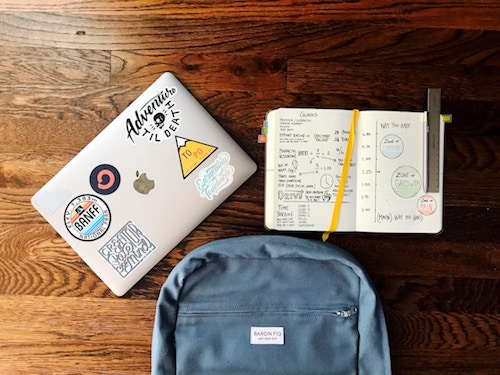
Computer and Notebook photo by Matt Ragland on Unsplash
The research spells out the academic advantages of taking notes by hand as:
- Improved memory retention — The act of physically writing notes engages more brain regions associated with memory formation, so students recall more vs. when they just type their notes.
- Forced summarization — When students write by hand, they must condense spoken words, narratives, asides, jokes, responses to students’ inquiries, etc. into key points. This process promotes “active learning” so the note-taker will better understand the material.
- Reduced distractions — Paper is boring. It just sits there, and unless you doodle, there’s nothing but your notes to look at, so distractions are minimized. On a computer or tablet, audio and text notifications pop up, tempting the note-taker to divide attention between mitochondria being the powerhouse of the cell and the a notification of the latest celebrity breakup.
- Visual organization — “Aha!” you’re thinking! Here’s where Paper Doll must be wrong. Surely you can do more to organize notes visually on a computer, because you can format important things in bold, italicize unusual terms, use different color text, or even highlight entire sections in different colors.
And yeah, you can, but not until later, after class, when you’re studying, and might no longer remember which things needed accenting. Plus, the cognitive component of studying is different from the one at play when you’re taking notes.
But when you’re taking notes contemporaneous with the lecture, you can:
-
- change from cursive to printing
- add block letters
- underline or circle key information
- draw diagrams
- put symbols in the margins (like an asterisk to say, “Hey, this will be on the test!” or a question mark to tell yourself, “I totally don’t get this. Go to office hours to ask the prof what this meant.”)
- use different pens (or sparkly ones!) to color-code as you go
- or use the geographic landscape of the page for different methods of learning the material. (That last part is key to the Cornell Note-Taking Method, which Frank and I discussed in the podcast, and which I’ll explain in greater detail in next week’s post.)
All of these advantages convince me, but one element of this “feels” the most believable to me. In a classroom setting, when we hand-write, we process first, then translate what we hear into those few, condensed phrases; when we type, we’re more likely to try to transcribe (almost) everything we hear, bypassing our brains and letting our fingers do the walking. We become like court stenographer, gathering the details without relating to them. When we transcribe, we may as well be an AI platform.
Of course, there are advantages for students to take academic notes on devices vs. writing in longhand.
-
-
- Typing is faster; when you’re feeling overwhelmed by the influx of information, typing may give you some breathing room to absorb what you’ve taken down in those few extra seconds vs. the pen-on-paper peeps.
- You can organize digital notes with pertinent headings, color-coding, and after-the-fact added graphics, plus you can copy & paste notes you’ve taken from the readings. If a professor makes an aside or expands on an earlier topic because a fellow student has asked for clarification, you can cut & paste the later blurb into the earlier, related section.
- Digital notes can be edited after the fact to make them make more sense. You can’t really edit notes in longhand; you can only re-write them.
- Digital notes are searchable, allowing you to key in on particular concepts.
-
If you’d like to geek out on this, avail yourself of these research papers and articles, arranged starting with the most recent:
- Digital Notes vs Paper Notes in 2025: Benefits of Taking Notes by Hand (January 2025)
- Why writing by hand beats typing for thinking and learning, NPR (May 2024)
- Handwriting but not typewriting leads to widespread brain connectivity: a high-density EEG study with implications for the classroom, F. R. (Ruud) Van der Weel and Audrey L. H. Van der Meer (January 2024)
- Advantage of Handwriting Over Typing on Learning Words: Evidence From an N400 Event-Related Potential Index (2021)
- Computers and productivity: Evidence from laptop use in the college classroom, Richard W. Patterson and Robert M. Patterson (2017)
- Note-taking and Handouts in The Digital Age (2015)
- The Pen Is Mightier Than the Keyboard: Advantages of Longhand Over Laptop Note Taking, Pam A. Mueller and Daniel M. Oppenheimer (April 2014)
Not everyone agrees on this, particularly in an academic setting. The politics of teaching (or not teaching) cursive writing, the neurobiology of how our brains process information when writing vs. typing, and the arguments of the relative merits of speed vs. comprehension make this a fighty topic in the world of education. Maybe I believe the research because I’m already inclined toward a slower, more analog approach to note-taking, or maybe it’s just (in Stephen Colbert’s words) the seeming truthiness of these researchers explanations. Students must find their own way.
As Frank and I discussed, however, it doesn’t have to be either/or.
In academic note-taking, as well as in all of the other note-taking situations described below, you have options.
A hybrid approach, one in which first-level notes can be taken in longhand, then digitized to be edited, organized, refined, and searched, is increasingly applicable, both for students and for most of these other situations.
OK, back to our regularly scheduled program.
Academic settings don’t just include taking notes in the classroom. Diligent students also take notes on what they’re reading, whether by writing on notepads or typing in a document, annotating books and documents by scribbling in the margins (or on transparent sticky notes, as I wrote about in See Your Way Clear: Organize With Transparent Sticky Notes), making flashcards, etc. We’ll look more at this aspect in the next post.
Non-Academic Learning and Skill-Building
When you’re not learning something for a grade, there’s less pressure on your note-taking skills; you may not have to learn as quickly, so you can focus on hitting the things that seem essential, as you can always go back to get help with the finer points. This category encompasses things like learning a new language, learning how to code, even gaining cooking skills.
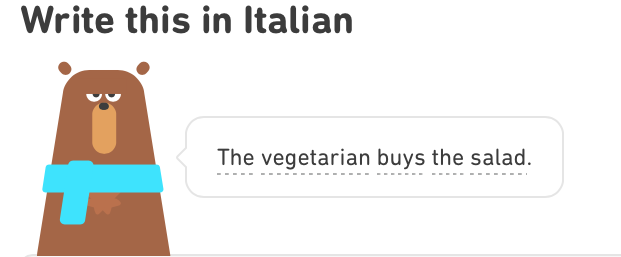
(Il vegetariano compra l’insalata. In case you were wondering.)
As with academic settings, you may take notes on what you hear from a lecturer (whether in person, on a webinar, or even watching a YouTube video), but you also may make experiential notes: telling your future self that you should only whip the sugar and eggs for two and a half minutes, not the three called for in the recipe, or that you should inhale after the fourth measure of the song you’re learning for choir so you’ll have the lung capacity to make it to the bridge or the chorus.
Conferences and Large-Scale Professional Settings
I’ve attended many NAPO conferences, and the educational offerings are tremendous. But I have to admit, sometimes I psych myself out when trying to take notes.
There’s a voice in the back of my head shouting, “You paid SO MUCH for this conference, air fare, hotel, and cute outfits so your colleagues don’t think you only own that one cardigan you always seem to be wearing on Zoom, so be sure to get EVERYTHING down in these notes.” Even though there’s no exam, there can be self-imposed pressure to capture every nugget of information.
I’ve written in the past about my attempts to take conference notes on my iPad vs. my traditional notepad method. The first year, I’d only had an iPad for a few weeks, didn’t yet own a smart phone, and was so delighted (and distracted) by the availability of email and texting (both of which I’d only had through my iMac at home) that I struggled to focus.
The next year, I wrote about my more concerted digital efforts in NAPO2014: Taking Notes–The Paperless Experiment. I provided the results of my experiment, but ruled that the jury was still out. At that time, I felt the jury was still out, and up until 2020, when the conference was canceled due to the pandemic, I was still not happy with a fully digital note-taking approach. Tech has come a long way in the last five years, making a hybrid method much more appealing.
Work Meetings
You know the expression about how, “This meeting could have been an email.” If it had been an email, you wouldn’t have had to take notes!
Because communication in meetings, even with agendas, can be ad hoc, there are fewer indicators of what is important to capture. Certainly, you want to write down any “next actions” assigned to you, but unless it’s your responsibility to take minutes in meetings, the best reason to take notes is to make sure you don’t get caught being distracted by things on your phone.
When I worked in TV, my otherwise stellar general manager would ask a department head to take notes during meetings when the executive assistant was on vacation. But he only ever asked women. (This was the 1990s.) It made me cranky, not only because it felt sexist that only half of us were ever asked to do it, but also because my handwriting was bad and I couldn’t engage meaningfully if I was playing stenographer.
The first time, I was only 25 and not yet confident enough to either say no or be maliciously compliant, so asked everyone to give me their speaking points and I’d type up a summary. The next time, I said, “No thank you. I’m sure it’s Larry’s turn.” Happily, Larry was much better at it, and after that, we passed a micro-cassette recorder around the table to record what each of us said, so nobody took notes.
Situational
These are “life” notes. They can range from serious, like the notes you might take if you or a loved one has just received a medical diagnosis and you want to write down the treatment options and next steps, to casual, like the notes you take when you make (or receive) a phone call and want to capture quick details like names, appointment times, or directions.
Research
Research notes encompass everything we take notes on where the information is not spoon-fed to us. Unlike in a lecture hall, webinar, or conference, this kind of information involves gathering data from multiple sources — books, periodicals, journals, interviews, and even scientific (or social science) experiments.
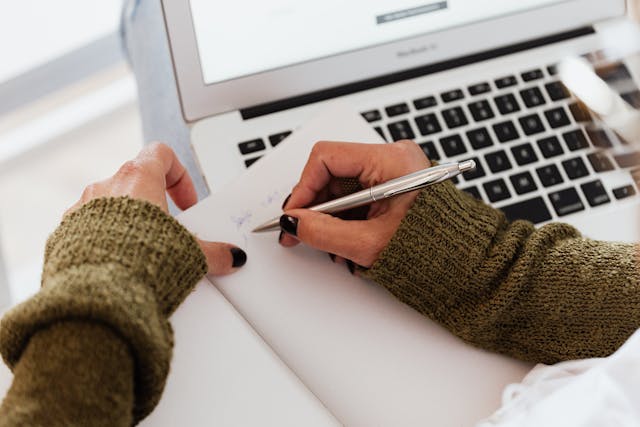
Notes by Hand and Computer, Photo by Kaboompics.com
Such notes may be taken by journalists, authors of non-fiction, students writing academic papers, graduate students writing a doctoral or other thesis, etc.
Creative
Unlike taking notes on research, which tends to be outwardly focused on what is found elsewhere, whether created by others or observed by the note-taking individual, creative note-taking is more personal.

Guitarist making musical by Artem Podrez
When you take creative notes — for example, if you’re a novelist, an artist, a musician, a designer, etc. — you are capturing your own thoughts and innovations in the form inspirations, lyrics, sketches, etc. Creative notes may involve words, drawings, musical notes, or other note-capturing formats.
Travel
If you’re planning travel, you might take notes on the research you’ve done regarding options for hotels, flights (or trains or ships), and sights, in advance of your trip. However, you might also make contemporaneous notes about changes in your itinerary, jot thoughts down for later journaling of experiences, or capture must-remember details, like what platform to switch to when you changing subway trains.
Legal and Financial
These are life notes with added importance, similar to the more serious situational notes. These might be require taking notes in a meeting or conversation with your attorney or investment advisor, or could involve making notes on what you’ve read (similar to the different academic note concepts).
For example, I have clients who’ve taken precise notes in divorce mediation meetings, combined with notes on each iteration of the divorce agreement until everything was finalized; for some, this was about having a sense of control during an emotionally roiling time.
If you’re negotiating a contract, figuring out how to invest for retirement or your child’s education, trying to structure a business, or deal with the best possible tax implications, you may want to take notes to help you better understand the options or to make sure that later on, you can reflect on why you chose to make the decisions you did.
Emergency or Crisis Situations
When you’re calm and nothing is distracting you, taking notes can be a perfectly ordinary (or boring) task. But in a crisis situation, when your mind is spinning, keeping track of information and urgent next steps can be overwhelming.
Calming your mind to make sense of things can be difficult if you’re the victim of a crime (as I wrote about in Organize to Prevent (or Recover From) a Car Theft) or there’s a family crisis (such as during the floods in western North Carolina this fall, when my client was trying to capture snippets of phone information while his elderly mother was being airlifted to safety).
During a crisis, taking notes gives you the opportunity to focus on something a little more tangible and removes some element of emotion from the process.
During a crisis, taking notes gives you the opportunity to focus on something a little more tangible and removes some element of emotion from the process. Share on XBack in 2017, Paper Mommy‘s heart surgery ran much longer than we were told it would, and when the doctor finally came to speak with me, he began explaining what had happened. I immediately started writing down what he said, but he discouraged me, saying I wouldn’t be able to get it. I stared him down, and our family friend encouraged him to keep talking.
When he was done, I said, “This is what I think I understand…” and proceeded in my own words to recap what had happened, what they were going to do next, and what the timeline was. This wasn’t just so that I could explain things later to my sister and my mom’s friends (or to prove the doctor wrong). Taking these notes was an essential part of making sense of what was going on in order to calm me down.
I’m not a doctor; I didn’t “need” to know the science of it. But as a daughter (and as a person who struggles when things are vague or confusing), I nonetheless needed to take these notes.
NOTE-TAKING: WHAT’S THE BEST METHOD FOR YOU?
When I initially told Frank I’d be delighted to be on his podcast again, I vaguely thought, “Oh, and then I can write a follow-up post with a few extra ideas. It’ll be a short post.” Well, long-time Paper Doll readers know how that usually turns out!
After recalling the handful of note-taking situations Frank and chatted about, I kept thinking of other, more narrow categories. Then, I’d figured I’d write a few paragraphs about the Cornell Note-Taking Method and a few other analog methods, and then give a nod to digital note-taking platforms.
But then I realized I’d completely skipped the idea of audio notes and AI!
The more I read of my own notes on note-taking (how meta of me!) from recent years, it became obvious that one post wasn’t going to be enough. So, if you’re trying to learn how to take better notes in webinars, or you have a high school or college student who is looking to improve how they capture and organize their notes, be sure to make a note (heh) to come back next week for the follow up.
Going forward, we’ll examine:
- analog note-taking methods you may not be familiar with (like the Cornell Note-Taking Method, Zettlekasten, the Ahrens’ Smart Notes Method, the Feynman Technique, mind-mapping, and more)
- digital note-taking platforms including, but beyond the big names like Evernote, OneNote, and Notion, and including apps for organizing learning, remembering, and being productive
- identifying which of these analog and digital methods might be initially better for the categories outlined earlier in this post
- how to create a hybrid system, combining the advantages of analog and digital note-taking
- the different capturing methods applicable for taking notes on things people are saying vs. concepts you’re reading/researching vs. ideas you’ve created on your own
I can’t guarantee you’ll have fewer meetings that should have been emails, that your novel will sell better, or that your kid will remember what happened in the War of Jenkins’ Ear. But you will have a broader idea of the varieties of note-taking options you have, and a better sense of which might work best for you in different circumstances.
Paper Doll Post:




Wow, lots of information. I’m going to share it with my college students group on Pinterest. Thanks for sharing your thoughts. I loved the interview. It was very informative. I sent it to my med school daughter.
Ooh, thank you, Sabrina. I think your college students will really like some of the material next week. That will be the real powerhouse, when I share the different note-taking methods. We tend to focus on just writing down “the stuff” but there are some really nifty methods for making notes so much more productive.
And thank you for watching the interview. Frank always makes the conversation flow!
That Cornell Note Taking Method sure brought back memories of taking notes in college. And I certainly can attest to the importance of taking notes when I was taking care of Rob – his log that I kept ended up at 145 pages of notes – all color coded.
I have found that even when I don’t refer back to notes – it they were handwritten they will stay in my mind and are there if I want to go back to reference them later.
Looking forward to your next blogs on the topic.
I will need to go back and listen to the podcast.
I know what you mean — and you’re echoing all of that research that says that the mind-body connection, that neurological magic of writing leading to encoding things in memory, is a real thing.
I think you’ll like Frank’s podcast; sometimes he has guests, but often he’s just sharing his wealth of knowledge on a topic.
Thanks for reading and sharing your thoughts!
Congratulations on the podcast! I haven’t listened to it yet and look forward to hearing your brilliance.
I’m a BIG note-taker. While I have taken notes digitally, more often, I prefer to write by hand for ALL of the reasons you mentioned. Not only does it help me remember what I’m learning or hearing, but it gives me a great document to refer to after if needed. There are times when portions of those hand-written notes get typed up. But more often than not, I begin with handwriting them.
I once did an experiment that was based on strengths and learning preferences. The assignment was to use a non-dominant strength in a situation. Shortly after, I attended a learning session for a volunteer position (Destination Imagination) I signed up for. Usually, I would have written notes while listening. Instead, I just listened and didn’t allow myself to pick up my pen. It was painful, viscerally painful. My head felt hot, my body was tense, and I couldn’t concentrate on anything the presenter said. I felt ill and stressed.
Fortunately, my husband was also there taking notes so that I could refer to his after. It was such an informative experience.
During most meetings and conversations, I pull out my favorite Levenger pad (with smooth, lovely paper), my favorite Pilot Razor Point pen, and a few highlighters. I’m ready to listen, capture, and engage.
It was fun. I’ve been on Frank’s show three (or four?) times, and he makes it a stellar experience.
I’m with you; I’m almost always taking notes by hand first. And yes, not taking notes feels disempowering for me, too; I think I can’t fully absorb what I’m hearing (or avoid distractions) if I can’t start writing it down. Now that you’ve tried using that non-dominant strength (listening, absent writing), you know what works best for you and why. You’ve got the receipts, as the kids say! (Do they still say it?)
“Listen, capture, and engage.” I’m quoting you for next week’s post!”
I like to take notes but I rarely go back to them. I have been considering using AI for now taking during zoom calls. It really takes quite a lot of time for me to write them up for the client.
Congrats on your new podcast.
I’ve got a section on AI coming up in the series; there are definitely times where we don’t have to actively take notes but can just review recaps. AI would be terrible for academic learning, where retention requires understanding, but excellent for capturing key points without a need for greater comprehension.
Thank you for reading and sharing your thoughts!
You manage to put an amazing amount of information in a limited space! I watched the Frank Buck video and your blog and the video brought back many memories and concerns. First, I took an Education class, How to Study in College, taught by Walter Pauk my first year in college. I still take notes with a 1/3-2/3s division down the middle of the page. Second,Frank reminded me of my first PDA, a Palm 100. I never was an optimum user.
Then you talked about all features of Evernote which made me feel like a total luddite. I’m looking forward to your next blog (and your future blog on AI). One of my sons asked AI to write my resume and it was incredibly accurate, and scary.
Thank you. PS Nice cardigan. 🙂
Thank you for the kind words (and the cardigan comment)! I’d never heard of the Cornell Note-Taking Method until I got to Cornell and learned about it in the lab for Bio 109, and assumed it was something just taught at Cornell; nobody at grad school knew about it and I hadn’t heard about it again until the internet connected people from far and wide, and I started researching these kinds of topics. It’s great to know about your experience in Pauk’s actual course. Was this in HumEc or A&LS?
And don’t feel bad; if you don’t use Evernote or look at the Google Lab apps, you wouldn’t know about these things, and as you don’t need them for work, you likely wouldn’t come across them. Still, it’s nice to know what’s out there. Thanks for your feedback!
[…] Take Note: Paper Doll’s Guide to Organized Note-Taking […]